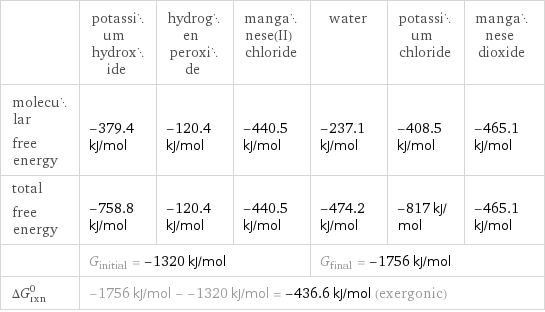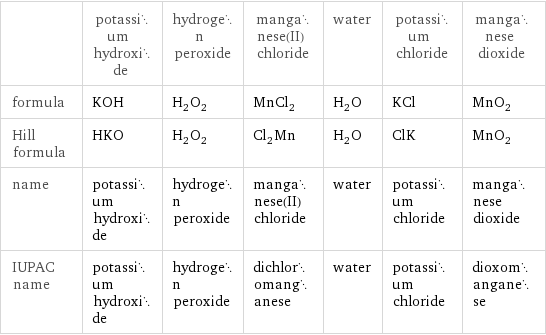Input interpretation

KOH (potassium hydroxide) + H_2O_2 (hydrogen peroxide) + MnCl_2 (manganese(II) chloride) ⟶ H_2O (water) + KCl (potassium chloride) + MnO_2 (manganese dioxide)
Balanced equation

Balance the chemical equation algebraically: KOH + H_2O_2 + MnCl_2 ⟶ H_2O + KCl + MnO_2 Add stoichiometric coefficients, c_i, to the reactants and products: c_1 KOH + c_2 H_2O_2 + c_3 MnCl_2 ⟶ c_4 H_2O + c_5 KCl + c_6 MnO_2 Set the number of atoms in the reactants equal to the number of atoms in the products for H, K, O, Cl and Mn: H: | c_1 + 2 c_2 = 2 c_4 K: | c_1 = c_5 O: | c_1 + 2 c_2 = c_4 + 2 c_6 Cl: | 2 c_3 = c_5 Mn: | c_3 = c_6 Since the coefficients are relative quantities and underdetermined, choose a coefficient to set arbitrarily. To keep the coefficients small, the arbitrary value is ordinarily one. For instance, set c_2 = 1 and solve the system of equations for the remaining coefficients: c_1 = 2 c_2 = 1 c_3 = 1 c_4 = 2 c_5 = 2 c_6 = 1 Substitute the coefficients into the chemical reaction to obtain the balanced equation: Answer: | | 2 KOH + H_2O_2 + MnCl_2 ⟶ 2 H_2O + 2 KCl + MnO_2
Structures

+ + ⟶ + +
Names

potassium hydroxide + hydrogen peroxide + manganese(II) chloride ⟶ water + potassium chloride + manganese dioxide
Reaction thermodynamics
Gibbs free energy

| potassium hydroxide | hydrogen peroxide | manganese(II) chloride | water | potassium chloride | manganese dioxide molecular free energy | -379.4 kJ/mol | -120.4 kJ/mol | -440.5 kJ/mol | -237.1 kJ/mol | -408.5 kJ/mol | -465.1 kJ/mol total free energy | -758.8 kJ/mol | -120.4 kJ/mol | -440.5 kJ/mol | -474.2 kJ/mol | -817 kJ/mol | -465.1 kJ/mol | G_initial = -1320 kJ/mol | | | G_final = -1756 kJ/mol | | ΔG_rxn^0 | -1756 kJ/mol - -1320 kJ/mol = -436.6 kJ/mol (exergonic) | | | | |
Equilibrium constant
![Construct the equilibrium constant, K, expression for: KOH + H_2O_2 + MnCl_2 ⟶ H_2O + KCl + MnO_2 Plan: • Balance the chemical equation. • Determine the stoichiometric numbers. • Assemble the activity expression for each chemical species. • Use the activity expressions to build the equilibrium constant expression. Write the balanced chemical equation: 2 KOH + H_2O_2 + MnCl_2 ⟶ 2 H_2O + 2 KCl + MnO_2 Assign stoichiometric numbers, ν_i, using the stoichiometric coefficients, c_i, from the balanced chemical equation in the following manner: ν_i = -c_i for reactants and ν_i = c_i for products: chemical species | c_i | ν_i KOH | 2 | -2 H_2O_2 | 1 | -1 MnCl_2 | 1 | -1 H_2O | 2 | 2 KCl | 2 | 2 MnO_2 | 1 | 1 Assemble the activity expressions accounting for the state of matter and ν_i: chemical species | c_i | ν_i | activity expression KOH | 2 | -2 | ([KOH])^(-2) H_2O_2 | 1 | -1 | ([H2O2])^(-1) MnCl_2 | 1 | -1 | ([MnCl2])^(-1) H_2O | 2 | 2 | ([H2O])^2 KCl | 2 | 2 | ([KCl])^2 MnO_2 | 1 | 1 | [MnO2] The equilibrium constant symbol in the concentration basis is: K_c Mulitply the activity expressions to arrive at the K_c expression: Answer: | | K_c = ([KOH])^(-2) ([H2O2])^(-1) ([MnCl2])^(-1) ([H2O])^2 ([KCl])^2 [MnO2] = (([H2O])^2 ([KCl])^2 [MnO2])/(([KOH])^2 [H2O2] [MnCl2])](../image_source/dfc41d38bc50ebe67e5d51ed4bbb17e0.png)
Construct the equilibrium constant, K, expression for: KOH + H_2O_2 + MnCl_2 ⟶ H_2O + KCl + MnO_2 Plan: • Balance the chemical equation. • Determine the stoichiometric numbers. • Assemble the activity expression for each chemical species. • Use the activity expressions to build the equilibrium constant expression. Write the balanced chemical equation: 2 KOH + H_2O_2 + MnCl_2 ⟶ 2 H_2O + 2 KCl + MnO_2 Assign stoichiometric numbers, ν_i, using the stoichiometric coefficients, c_i, from the balanced chemical equation in the following manner: ν_i = -c_i for reactants and ν_i = c_i for products: chemical species | c_i | ν_i KOH | 2 | -2 H_2O_2 | 1 | -1 MnCl_2 | 1 | -1 H_2O | 2 | 2 KCl | 2 | 2 MnO_2 | 1 | 1 Assemble the activity expressions accounting for the state of matter and ν_i: chemical species | c_i | ν_i | activity expression KOH | 2 | -2 | ([KOH])^(-2) H_2O_2 | 1 | -1 | ([H2O2])^(-1) MnCl_2 | 1 | -1 | ([MnCl2])^(-1) H_2O | 2 | 2 | ([H2O])^2 KCl | 2 | 2 | ([KCl])^2 MnO_2 | 1 | 1 | [MnO2] The equilibrium constant symbol in the concentration basis is: K_c Mulitply the activity expressions to arrive at the K_c expression: Answer: | | K_c = ([KOH])^(-2) ([H2O2])^(-1) ([MnCl2])^(-1) ([H2O])^2 ([KCl])^2 [MnO2] = (([H2O])^2 ([KCl])^2 [MnO2])/(([KOH])^2 [H2O2] [MnCl2])
Rate of reaction
![Construct the rate of reaction expression for: KOH + H_2O_2 + MnCl_2 ⟶ H_2O + KCl + MnO_2 Plan: • Balance the chemical equation. • Determine the stoichiometric numbers. • Assemble the rate term for each chemical species. • Write the rate of reaction expression. Write the balanced chemical equation: 2 KOH + H_2O_2 + MnCl_2 ⟶ 2 H_2O + 2 KCl + MnO_2 Assign stoichiometric numbers, ν_i, using the stoichiometric coefficients, c_i, from the balanced chemical equation in the following manner: ν_i = -c_i for reactants and ν_i = c_i for products: chemical species | c_i | ν_i KOH | 2 | -2 H_2O_2 | 1 | -1 MnCl_2 | 1 | -1 H_2O | 2 | 2 KCl | 2 | 2 MnO_2 | 1 | 1 The rate term for each chemical species, B_i, is 1/ν_i(Δ[B_i])/(Δt) where [B_i] is the amount concentration and t is time: chemical species | c_i | ν_i | rate term KOH | 2 | -2 | -1/2 (Δ[KOH])/(Δt) H_2O_2 | 1 | -1 | -(Δ[H2O2])/(Δt) MnCl_2 | 1 | -1 | -(Δ[MnCl2])/(Δt) H_2O | 2 | 2 | 1/2 (Δ[H2O])/(Δt) KCl | 2 | 2 | 1/2 (Δ[KCl])/(Δt) MnO_2 | 1 | 1 | (Δ[MnO2])/(Δt) (for infinitesimal rate of change, replace Δ with d) Set the rate terms equal to each other to arrive at the rate expression: Answer: | | rate = -1/2 (Δ[KOH])/(Δt) = -(Δ[H2O2])/(Δt) = -(Δ[MnCl2])/(Δt) = 1/2 (Δ[H2O])/(Δt) = 1/2 (Δ[KCl])/(Δt) = (Δ[MnO2])/(Δt) (assuming constant volume and no accumulation of intermediates or side products)](../image_source/025373e216b99ace04e57b481e20467a.png)
Construct the rate of reaction expression for: KOH + H_2O_2 + MnCl_2 ⟶ H_2O + KCl + MnO_2 Plan: • Balance the chemical equation. • Determine the stoichiometric numbers. • Assemble the rate term for each chemical species. • Write the rate of reaction expression. Write the balanced chemical equation: 2 KOH + H_2O_2 + MnCl_2 ⟶ 2 H_2O + 2 KCl + MnO_2 Assign stoichiometric numbers, ν_i, using the stoichiometric coefficients, c_i, from the balanced chemical equation in the following manner: ν_i = -c_i for reactants and ν_i = c_i for products: chemical species | c_i | ν_i KOH | 2 | -2 H_2O_2 | 1 | -1 MnCl_2 | 1 | -1 H_2O | 2 | 2 KCl | 2 | 2 MnO_2 | 1 | 1 The rate term for each chemical species, B_i, is 1/ν_i(Δ[B_i])/(Δt) where [B_i] is the amount concentration and t is time: chemical species | c_i | ν_i | rate term KOH | 2 | -2 | -1/2 (Δ[KOH])/(Δt) H_2O_2 | 1 | -1 | -(Δ[H2O2])/(Δt) MnCl_2 | 1 | -1 | -(Δ[MnCl2])/(Δt) H_2O | 2 | 2 | 1/2 (Δ[H2O])/(Δt) KCl | 2 | 2 | 1/2 (Δ[KCl])/(Δt) MnO_2 | 1 | 1 | (Δ[MnO2])/(Δt) (for infinitesimal rate of change, replace Δ with d) Set the rate terms equal to each other to arrive at the rate expression: Answer: | | rate = -1/2 (Δ[KOH])/(Δt) = -(Δ[H2O2])/(Δt) = -(Δ[MnCl2])/(Δt) = 1/2 (Δ[H2O])/(Δt) = 1/2 (Δ[KCl])/(Δt) = (Δ[MnO2])/(Δt) (assuming constant volume and no accumulation of intermediates or side products)
Chemical names and formulas

| potassium hydroxide | hydrogen peroxide | manganese(II) chloride | water | potassium chloride | manganese dioxide formula | KOH | H_2O_2 | MnCl_2 | H_2O | KCl | MnO_2 Hill formula | HKO | H_2O_2 | Cl_2Mn | H_2O | ClK | MnO_2 name | potassium hydroxide | hydrogen peroxide | manganese(II) chloride | water | potassium chloride | manganese dioxide IUPAC name | potassium hydroxide | hydrogen peroxide | dichloromanganese | water | potassium chloride | dioxomanganese
Substance properties

| potassium hydroxide | hydrogen peroxide | manganese(II) chloride | water | potassium chloride | manganese dioxide molar mass | 56.105 g/mol | 34.014 g/mol | 125.8 g/mol | 18.015 g/mol | 74.55 g/mol | 86.936 g/mol phase | solid (at STP) | liquid (at STP) | solid (at STP) | liquid (at STP) | solid (at STP) | solid (at STP) melting point | 406 °C | -0.43 °C | 652 °C | 0 °C | 770 °C | 535 °C boiling point | 1327 °C | 150.2 °C | | 99.9839 °C | 1420 °C | density | 2.044 g/cm^3 | 1.44 g/cm^3 | 2.98 g/cm^3 | 1 g/cm^3 | 1.98 g/cm^3 | 5.03 g/cm^3 solubility in water | soluble | miscible | | | soluble | insoluble surface tension | | 0.0804 N/m | | 0.0728 N/m | | dynamic viscosity | 0.001 Pa s (at 550 °C) | 0.001249 Pa s (at 20 °C) | | 8.9×10^-4 Pa s (at 25 °C) | | odor | | | | odorless | odorless |
Units
